This is a fortnightly newsletter about the New Zealand Net. If you would like to be notified by email when a new edition is published, please contact ZL1NZ.
Browse our newsletter archive.
Featured key
Steve Roberts W1SFR makes a selection of straight keys, sideswipers and paddles that use no springs or magnets – they use torsion bars, as shown in the video above.
Have you used a torsion bar key?
Quick notes
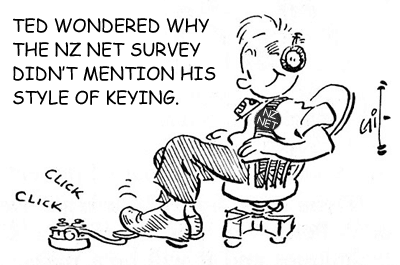
In the last issue, we had a little survey about which hand people use for keying, and the results are quite interesting. We also heard from a couple of newsletter readers with stories of learning to key “backwards”. Read on for all the details.
Steve ZL2KE ran a busy net on 26 Nov, with six pieces of traffic listed. I’m pretty sure that’s a new record for NZ Net. All the messages were addressed to me (lucky, huh?) and were responses to the trivia question (“what is the significance to hams of the number 0R707 where R is the Morse symbol for a decimal point?”). Our talented ops each managed to find a unique way of answering it, so it was good fun for everyone listening.
This is a good time of year to get on the 20m CWB net. Manny VK3DRQ was armchair copy here during a recent 20m net. The CWB (Communicators Without Borders) Net meets at 0600Z (7pm NZDT) on 14349.0 kHz.
Did I mention that Straight Key Night is coming soon? In case you’ve missed my avalanche of reminders, SKN will be Sunday 6 Dec from 9 to 10pm. Please don’t forget the QSY Rule!
noonsite.com is a website for cruising yachties and they have added NZ Net to their directory of radio nets in the Pacific. So perhaps one day we’ll hear from a maritime mobile station.
Cartoon: Philip (Gil) Gildersleeve
Photo flashback
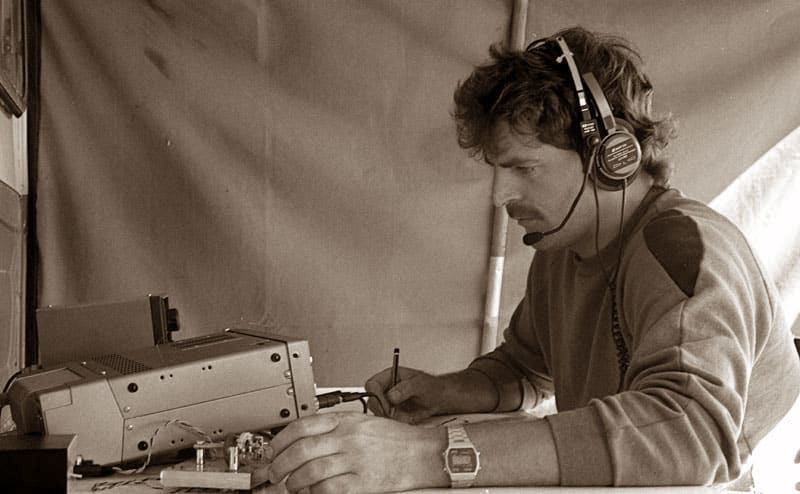
New Zealand’s wireless pioneers often worked in primitive conditions, sometimes living in tents and spending long hours at the key as they struggled to get their messages through. The pay was low, but a persistent operator with a good fist could earn what they referred to as “branch multipliers”.
Keep reading to learn more about this dedicated wireless man.
Morse musings
In the previous newsletter we had a little survey about left-handed versus right-handed keying, and here are the results:
Which hand do you use for sending Morse?
- I am right-handed and key with my right hand: 14 (70%)
- I am right-handed but key with my left hand: 1 (5%)
- I am left-handed and key with my left hand: 2 (10%)
- I am left-handed but key with my right hand: 2 (10%)
- Whichever is closer to the key (ambidextrous): 0
- Depends on the key (e.g. one hand for paddles, the other for a bug): 1 (5%)
And here are some personal tales of learning to key “backwards” from a couple of NZ Net News readers:
Tales of a left-handed bugger
 By Peter VE3EYI
By Peter VE3EYI
After getting my amateur radio licence in 1961 I used a WW2 surplus J-38 straight key, but found that it was not really designed for rag chewing much over 15wpm.
I started to fixate on a full-colour picture of a chrome-plated deluxe Vibroplex semi-automatic key in the catalogue published by Payette Radio in Montreal. I knew it would take a while before I could afford it but I thought it would be clever to start practising the new hand motion that would be required. And so, I would hold a 12-inch wooden ruler in my left hand with the thin edge on the table and use the free end to simulate the keying of a bug. I got pretty good at it and it didn’t seem to affect my use of the straight key.
In 1962 I had finished high school and had a job at the local TV station, which paid actual money, so I ordered my dream key from Payette. Serial number 227504 soon arrived, was quickly unpacked, admired and positioned in place of my training ruler.
It was immediately apparent that something was wrong. Pushing the little round red button didn’t produce a string of dots but the long oval paddle did. Exactly opposite of what I had assumed from the picture in the catalogue.
Try as I might, my right hand, having spent countless hours being imprinted with the wrong muscle action, could just not cope with the new bug. I was feeling pretty hopeless.
Then I wondered: ‘What if I used my non-imprinted left hand and trained it instead?’. Well, guess what, in spite of having zero hours engagement with the training ruler, my left hand turned out to function in mirror image to my incorrectly trained right hand, i.e. left fingers made dits, thumb made dahs.
The final step was to swap the round and oval paddles (see photo below). Now, rag chewing was not carpal tunnel-inducing and I didn’t have to put my pencil down to send or, if I did, I could fiddle with knobs and switches with my right hand. My ham friends started referring to me as ‘the left-handed bugger,’ but I think they meant it as a compliment.

Recently, I acquired an old Bencher BY-1 paddle and paired it with a Daiwa keyer from a hamfest. I thought it would make sense to use my right hand on the paddles so as not to screw up the bug action on my left. Didn’t work, even though I swapped the paddle function. My right had did manual dashes, full stop.
So, the bug and the paddles (wired to match) live on the left side of my desk. After a short time my brain learned to automatically adapt to auto or manual dashes depending which key I was using.
The straight key remains on the right because, try as I might, my left hand is just too old to cope with something new. And my brain has decided that iambic is something which is best learned at your mother’s knee.
Left hand keying for this righty
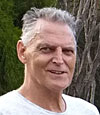 By Paul ZL1AJY
By Paul ZL1AJY
I purchased a paddle around 1986 at the Cambridge junk sale. It was a Bencher knock-off. The keyer kit came from a dealer here in Auckland.
I had no idea how this was supposed to work or which paddle was dashes or dots. Simply plugged in into my new TS440S, setting the contact gap and speed to about 16 wpm. Learning left handed was perfectly sensible, as it made no difference learning something completely new.
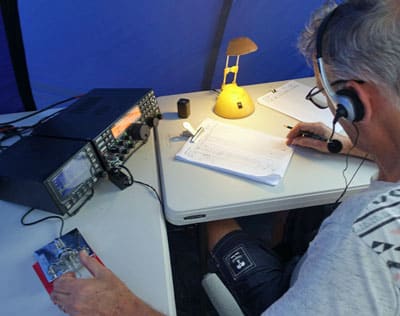 After a few evenings, keying left handed iambic became natural…along with a lot of mistakes and stumbles on the way. As it turned out, I had the dot and dash reversed; this makes no difference with an electronic keyer but a bonus is a right handed operator can use my key without swapping dot/dash sides.
After a few evenings, keying left handed iambic became natural…along with a lot of mistakes and stumbles on the way. As it turned out, I had the dot and dash reversed; this makes no difference with an electronic keyer but a bonus is a right handed operator can use my key without swapping dot/dash sides.
Years ago I noticed my new left handedness in odd places; I peel oranges and eggs left-handed and have always used a cell phone in left hand, and the TV remote is a left handed operation.
Pictured: ZL1AJY during the 2020 Jock White Field Day at ZL1XH. That’s also Paul in the Photo Flashback above, during the 1988 Field Day at ZL1BQ.
Scrambled signals
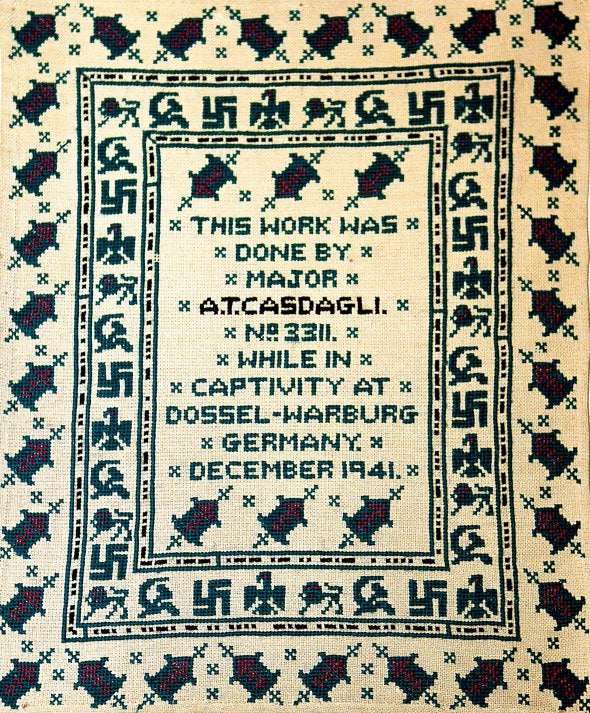 Alexis Casdagli was a British Army Major who was captured by the Germans during World War 2. During his four years as a prisoner of war he created several cross-stitch samplers, including this one which was even put on display by his captors.
Alexis Casdagli was a British Army Major who was captured by the Germans during World War 2. During his four years as a prisoner of war he created several cross-stitch samplers, including this one which was even put on display by his captors.
The Germans apparently didn’t recognise the two messages, written in Morse Code, woven into the sampler.
To win the virtual chocolate fish, be the first person to tell me what the two messages say. Email your reply. (I think you’ll agree that sending your answer over the air would be highly inappropriate in this case.)
And then you might like to read more about Major Casdagli.
UPDATE: We have a winner! Congratulations Don ZL2LDX
Winner of the previous challenge
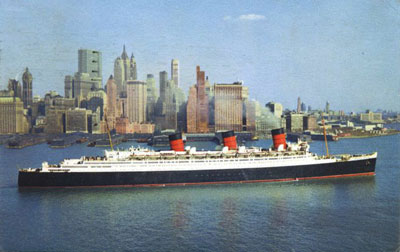 The previous newsletter featured a snippet of audio recorded in 1967 as RMS Queen Mary was sending an informal message to a US coast station.
The previous newsletter featured a snippet of audio recorded in 1967 as RMS Queen Mary was sending an informal message to a US coast station.
Gil ZL4CU was the first of several readers to tell me the location of Queen Mary when she sent that message.
Here’s the message transcribed:
<CT> WSC DE GBTT =
TO MANAGER AND STAFF WSC TUCKERTON RADIO =
AS WE TAKE OUR LEAVE OF NEW YORK AND REGRETFULLY STEAM DOWN THE HUDSON FOR THE LAST TIME WE SEND YOU ALL OUR THANKS AND APPRECIATION FOR THE COOPERATION EXTENDED TO US OVER THE YEARS BEST WISHES AND OUR KINDEST REGARDS =
RADIO STAFF GBTT <AR>
CAN YOU HELP? I’m running low on material for this feature, so if you have found something that would make an interesting Morse puzzle, please drop me a line.
CW attracting new ops
Steve ZL2KE forwarded this, from a recent report by Joe AA8TA, one of the co-managers of CW Academy – a very popular online training programme. It makes encouraging reading.
“We had 81 advisors lead a class this last semester, which is among the highest number of advisors that we have had. The CW Academy has grown remarkably from its humble origins years ago.
“There were 169 students who successfully completed a beginner class, 107 students who successfully completed a basic class, 62 students successfully completed an intermediate class and 47 students who successfully completed an advanced class. Several students have signed up to repeat a class that they took. Of those who were not able to successfully complete a class, hopefully they learned enough to try to improve on their own or to try a class again later on.”
That isn’t solid state!
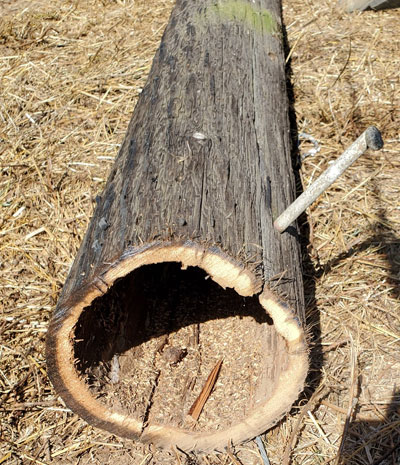 From the crew at KPH San Francisco Radio:
From the crew at KPH San Francisco Radio:
“Though our operations are still shut down due to Covid 19, contractor work continues. The photo is a pole at Bolinas (the KPH transmitter site) that was found to be hollowed out by carpenter bees.
“From the outside things appeared normal but while working on the H frames (feedline gantries) and cross arms, this came as a surprise and another pole had to be brought in.
“The weather has been nice to allow large equipment to get into the antenna field.”
Photo: Maritime Radio Historical Society
Net tip: acting as a relay station – part 2
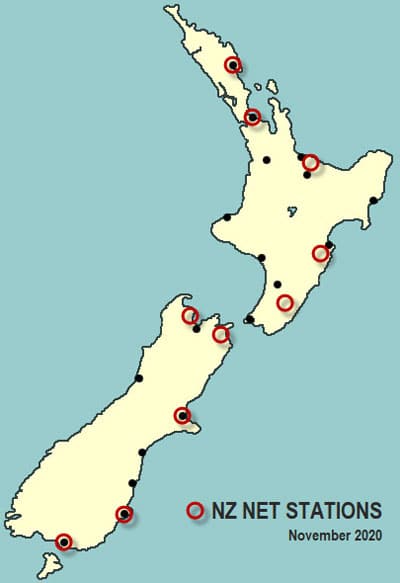 The most common type of relay you’ll hear on NZ Net, is when NCS asks another station to take over temporarily.
The most common type of relay you’ll hear on NZ Net, is when NCS asks another station to take over temporarily.
We do this to maximise the number of stations that can hear the net. (You might have noticed that if NCS is in the North Island, they will generally ask a strong South Island station to assist them, and vice versa.)
In this situation, we use a variation of the net code QNG (“Please take over as Net Control”).
The variation is QNG1, by which we mean “Please take over as NCS, call for check-ins, and turn it back to regular NCS after you have made ONE call without receiving a response.”
Sounds complicated when I explain it, but it’s pretty easy to understand when you hear it on the Net.
Here’s an example.
More to come in future newsletters. Please let me know if there are specific aspects of relaying that you would like me to cover.
Suggestions?
If you have suggestions on how to make the NZ Net better, or things you’d like to see covered in these updates, please contact ZL1NZ. You might even like to write something for the newsletter.
Thanks for reading, and I hope to see you soon on the NZ Net!
—
Neil Sanderson ZL1NZ, Net Manager
New Zealand Net (NZ NET)
3535.0 kHz at 9pm NZT Mon-Fri



